
archives for 06/2009
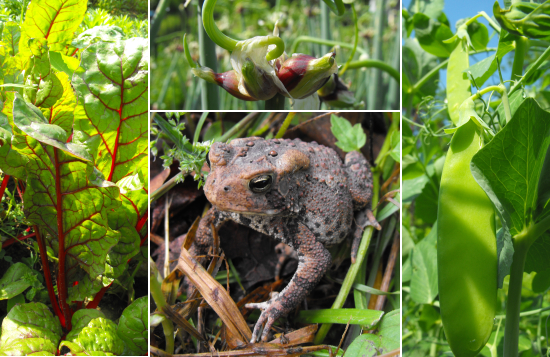
There is far too much in the garden now to fit into a single collage,
so I just snapped images which caught my eye. The swiss chard is
zooming upward, replacing the spinach which is starting to bolt.
Egyptian onion bulbs are maturing at the top of stalks. (Stay
tuned for a giveaway in the next few weeks!) The snow peas are
ready for a daily harvest, their vines poking over the top of their
five foot trellis. And toads are a ubiquitous presence.
Unpictured, we're still eating lettuce and strawberries and shiitakes,
our tomato transplants have gotten their feet under them and are
starting to grow, and the cabbage is beginning to head up. Both
basil and parsley are nearly ready for the first nibbles, and everyone
else is in the ground. Our sweet potato
starting operation has already churned out enough slips for five beds,
and I expect to put in a few more over the next week or two.
We're still weeding like mad, but I can feel us changing over to
irrigation and freezing season. The garden locomotive is running
at full speed!
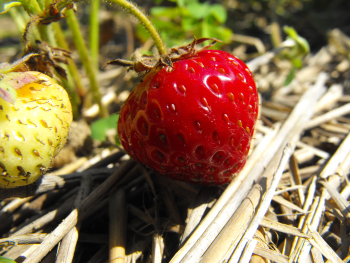 I
started reading up on plant micronutrients when I noticed that our
strawberries weren't as tasty this year as last year. Sure, the
heavy rains a few weeks ago probably contributed to the lack of
sweetness, but strawberries that I'd transplanted to
new beds last fall were tastier than strawberries that had been in the
same beds for over two years. Could the old strawberries have
used up micronutrients in their soil, resulting in less tasty fruits?
I
started reading up on plant micronutrients when I noticed that our
strawberries weren't as tasty this year as last year. Sure, the
heavy rains a few weeks ago probably contributed to the lack of
sweetness, but strawberries that I'd transplanted to
new beds last fall were tastier than strawberries that had been in the
same beds for over two years. Could the old strawberries have
used up micronutrients in their soil, resulting in less tasty fruits?
As I read up on micronutrients, an astonishing story emerged. The
conventionally grown crops you buy in the grocery store are churned out
in massive quantities through farming practices which feed the soil
with chemical fertilizers. These fertilizers provide the plants
with the big three nutrients --- nitrogen, phosphorus, and potassium
--- which is a lot like feeding a human solely on artificial protein,
starch, and fats. Over a few years, the crop plants use up all of
the micronutrients in the soil and start producing food which is also
deficient in those micronutrients. An unreferenced post
on Wikipedia
suggests that dealing with these micronutrient deficiencies could make
us 10% smarter. And maybe make our strawberries tastier?
| This post is part of our Micronutrient lunchtime series.
Read all of the entries: |
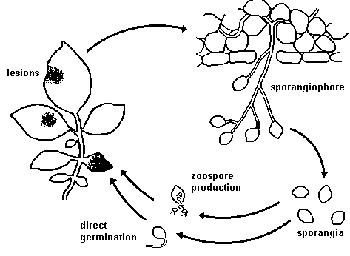 I was talking to the local hardware store
owner today about grape fungus and tomato blight.
I was talking to the local hardware store
owner today about grape fungus and tomato blight.
Phil: "You know what the old timers used to do about blight back in the
day when all they had to get by on was their imagination and sweat?"
Me: "Uhhh...no. I don't have a clue?"
Phil: "Copper wire...you take a short piece of electrical wire and poke
a hole in the stem of a mature tomato plant...leave it in there. That was supposed to help
with the blight somehow."
Me: "Have you ever tried it?"
Phil: : "Heck no....I'm not an old timer!"
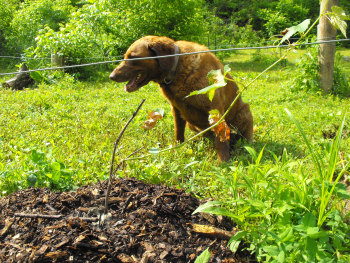 My perennial fruit learning curve remains
steep. I learned the hard way that I have to plant
fruit trees in raised beds in the worn out, clay part of the
yard. But for some reason I planted the grapes straight into the
ground.
My perennial fruit learning curve remains
steep. I learned the hard way that I have to plant
fruit trees in raised beds in the worn out, clay part of the
yard. But for some reason I planted the grapes straight into the
ground.
So I wasn't entirely surprised to find that about a fifth of those
grapes didn't leaf out this spring. I'm pretty sure their roots
drowned in the waterlogged soil.
Luckily, I had some spare plants left over that I transplanted into
raised mounds last week. This is totally the wrong time of year
to transplant grapes, but with some good watering and mulching, the
transplants seem to have sprung back only a few days later.
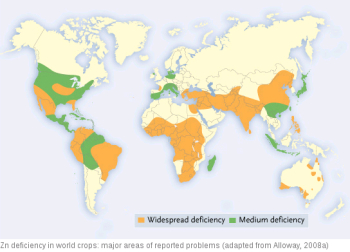 So,
what are micronutrients? Simply put, micronutrients are anything
required by plants for proper growth that are needed only in very small
quantities. Plant micronutrients are analagous to human vitamins
and minerals --- without them, plants usually keep growing, but they
often grow slower or have problems.
So,
what are micronutrients? Simply put, micronutrients are anything
required by plants for proper growth that are needed only in very small
quantities. Plant micronutrients are analagous to human vitamins
and minerals --- without them, plants usually keep growing, but they
often grow slower or have problems.
Wikipedia
lists eight main micronutrients which affect plant growth:
- Boron
- Chlorine
- Cobalt (especially important for nitrogen fixing plants like legumes)
- Copper
- Iron
- Manganese (availability depends on soil pH)
- Molybdenum (especially important for nitrogen fixing plants like legumes)
- Zinc
| This post is part of our Micronutrient lunchtime series.
Read all of the entries: |

We found our first wax moth cocoon today in one of the hives.
That means the larvae has been burrowing into the beeswax comb looking
for impurities, which they live on. They don't eat any wax, but their
little caves can cause honey to spill out, making more work for the
colony to repair.
I wonder if a small wax moth population might have benefits for the
colony by having impurities removed?
I am just starting to
garden in a new area and the soil is drying
out way too fast, 12 hours. I have killed more than 1/2 of what I have
planted. Some things are doing good in this but others just die, some
in less than a day. I do have a compost pile and it is cooking down but
isn't ready yet. Is there something else cheap (we live on a fixed
income) I can do to help hold the moisture in the soil? I am in zone 8b
in southern Alabama. It is in the high 80s/low 90s daily now.
---
Lynne
 We
have too much clay, not too much sand, but the solution to the both is
the same --- more organic matter. If you live close to a grocery
store, you might consider talking to the folks in the produce
department and asking them to hang onto old fruits and vegetables for
you to put in your compost pile, ramping up your volume. Starting
a worm colony would be an option to make your composting process move
along more quickly too.
We
have too much clay, not too much sand, but the solution to the both is
the same --- more organic matter. If you live close to a grocery
store, you might consider talking to the folks in the produce
department and asking them to hang onto old fruits and vegetables for
you to put in your compost pile, ramping up your volume. Starting
a worm colony would be an option to make your composting process move
along more quickly too.
While you're working on
your compost, you should still be able to come up with
mulch...
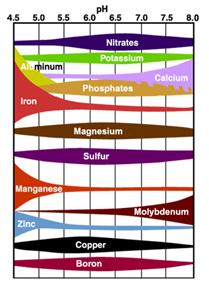 Although Wikipedia's list of
micronutrients just includes the generally accepted "little eight", I
keep
stumbling across other micronutrients which are important. For
example, a deficiency of magnesium in the
soil makes it hard for plants to use calcium, which in turn can lead to
blossom end rot in tomatoes. Magnesium can be easily washed out
of the upper layer of soil
by rain or watering, only to be returned when leaves from deep-rooted
plants (like trees) are added back to the ground.
Although Wikipedia's list of
micronutrients just includes the generally accepted "little eight", I
keep
stumbling across other micronutrients which are important. For
example, a deficiency of magnesium in the
soil makes it hard for plants to use calcium, which in turn can lead to
blossom end rot in tomatoes. Magnesium can be easily washed out
of the upper layer of soil
by rain or watering, only to be returned when leaves from deep-rooted
plants (like trees) are added back to the ground.
After extensive web
browsing, I've add these additional micronutrients to the little eight:
- Sodium
- Iodine
- Fluorine
- Silicon
- Sulfur
- Magnesium
- Calcium
Given that the most
recent of the little eight micronutrients was found
to have an effect on plants only about twenty years ago, I wouldn't be
surprised if we come up with more micronutrients which affect plants.
| This post is part of our Micronutrient lunchtime series.
Read all of the entries: |
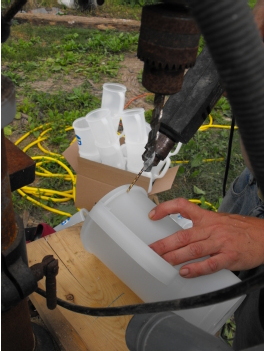 The June/July issue of Backyard Poultry hit the
streets on Saturday and I couldn't be happier with how Anna's full page
article on page 36 came out.
The June/July issue of Backyard Poultry hit the
streets on Saturday and I couldn't be happier with how Anna's full page
article on page 36 came out.
We've been getting some good feedback on how much happier chicken
chores can be with this new concept in backyard poultry watering.
It's exciting to see an idea go from the drawing board to reality in
the span of a few months. I was thinking today that our operation is a
level below most small business set-ups, which inspired me to call it a
micro-business. The name has been around for a while, and Lloyd Lemons is one of the
top sources for all things related to these smallest of businesses.
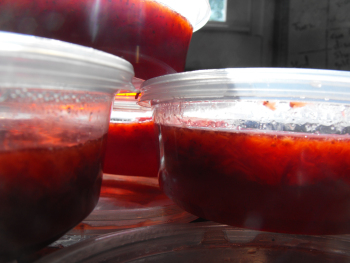 I'm starting to realize that jam has a
definite place in farm life. Last year, I froze our few excess
berries as-is, and while they were tasty once thawed, they weren't
phenomenal.
I'm starting to realize that jam has a
definite place in farm life. Last year, I froze our few excess
berries as-is, and while they were tasty once thawed, they weren't
phenomenal.
Then Mark's mom gave us some homemade strawberry freezer jam.
Wow-whee! We thinned that jam down and mixed it into salad as
dressing, ate it in gobs on pancakes, and even spread it on cakes as
frosting.
So this year, I hunted down the remarkably easy Strawberry Freezer Jam
recipe and used it on my excess strawberries from the less tasty
beds. The recipe is on the inside of the package of Sure-Jell
pectin (less or no sugar type), but I'll reproduce
it after the cut because it's surprisingly hard to find on the
internet....
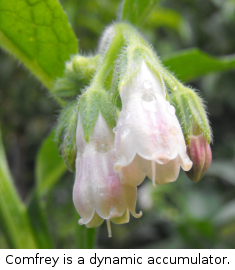 The big chemical
companies are now considering adding micronutrients into their chemical
fertilizer mixes along with nitrogen, potassium, and phosphorus.
As usual, I don't think that's the best option.
Instead, I like the idea of building up the soil by adding naturally
occurring micronutrients through compost, manure, and mulch.
The big chemical
companies are now considering adding micronutrients into their chemical
fertilizer mixes along with nitrogen, potassium, and phosphorus.
As usual, I don't think that's the best option.
Instead, I like the idea of building up the soil by adding naturally
occurring micronutrients through compost, manure, and mulch.
A related option, favored by permaculturalists, is to use dynamic
accumulators to add micronutrients back
into their topsoil. These plants are able to latch onto
micronutrients
in the soil, either by sending roots deep into the subsoil where the
micronutrients are plentiful, or by simply having a greater affinity to
micronutrients. Either way, the dynamic accumulators end up with
high
levels of certain micronutrients in their leaves. We can cut
these
leaves off and use them as mulch or compost around micronutrient
deficient plants, refreshing the micronutrient content of the soil.
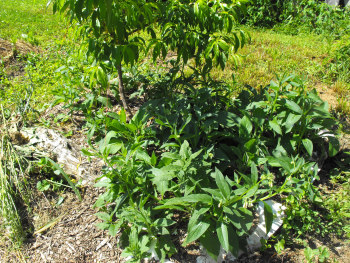
Comfrey is everyone's
favorite dynamic accumulator since it
concentrates silicon, nitrogen, magnesium, calcium, potassium, and
iron. In my young forest garden, I've planted comfrey around my
nectarine tree. As the comfrey gets to be a foot tall or so, I
whack
it all down and let it rot back into the soil, feeding my tree.
| This post is part of our Micronutrient lunchtime series.
Read all of the entries: |
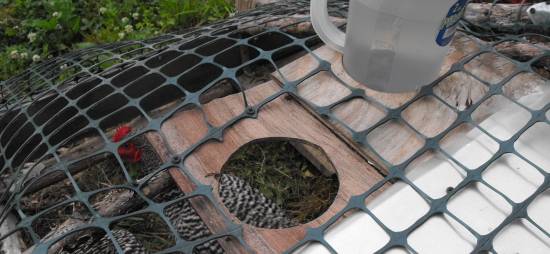
A 4.5 inch diameter hole cut in a piece of scrap plywood makes a very
smooth holder for the Avian Aqua Miser.
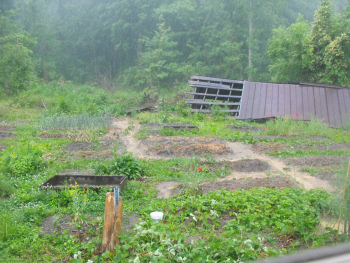 A quick downpour Wednesday reminded me why the
aisles between my raised beds are full of plants rather than bare
dirt. Notice the rivulets of water running down the aisles in the
photo? Those are the aisles which are currently bare clay,
recently disturbed during our drinking water trench project.
A quick downpour Wednesday reminded me why the
aisles between my raised beds are full of plants rather than bare
dirt. Notice the rivulets of water running down the aisles in the
photo? Those are the aisles which are currently bare clay,
recently disturbed during our drinking water trench project.
Our entire garden is on a slight slope, which would be a major erosion
hazard with conventional farming techniques. But between our
permanent raised beds and grass/clover aisles, I don't think we have
any erosion. Even better, I can run the mulching mower down the
aisles and net a bed's worth of mulch every week!
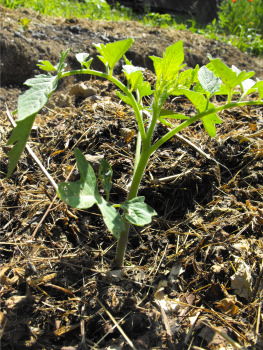 Although comfrey is a
well-known dynamic accumulator, there are plenty of other plants which
serve a similar function. The Oregon Biodynamic Group has a very
useful table of dynamic
accumulators and the micronutrients they concentrate.
Although comfrey is a
well-known dynamic accumulator, there are plenty of other plants which
serve a similar function. The Oregon Biodynamic Group has a very
useful table of dynamic
accumulators and the micronutrients they concentrate.
Reading over the chart, I'm drawn to two weeds which already grow well
in my "yard" --- broadleaf plantain and dandelions. Both
accumulate six (or
more) micronutrients and spring right back after hard cutting.
Plantain has the added bonus of growing very well in high traffic areas
where most plant life fades away.
In fact, between harvesting comfrey,
dandelions, and plantain, I'd come up with all except four of the 15
listed micronutrients. With the help our our new mulching
lawnmower,
I've been adding cuttings from these and other weeds around the base of
our strawberries and tomatoes to help the soil rebound. I also
feed my soil
manure, which is reported to be a good source of all micronutrients
except boron and zinc.
I'm as guilty as everyone else of thinking "nitrogen, nitrogen,
nitrogen!" But just as I'd never serve a meal without some fruits
or vegetables on the side, I think we need to stay aware of
micronutrients as we feed our gardens.
| This post is part of our Micronutrient lunchtime series.
Read all of the entries: |
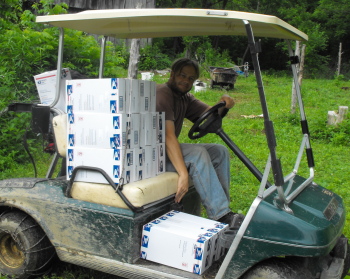 Dawn Rivers Baker has an excellent blog on microbusinesses
that pointed me towards a post on bootstrapping that I thought would be
worth sharing.
Dawn Rivers Baker has an excellent blog on microbusinesses
that pointed me towards a post on bootstrapping that I thought would be
worth sharing.
Tim Berry sat down with his wife recently and came up with 10
lessons they've learned over the last 22 years of running their
business.
At the top of the list was learning from your mistakes. It got me to
thinking how much we learned a couple of years ago from a failed
attempt to video tape and sell footage of local parades. We lost money
on the deal, and spent a lot of time producing each product, but those
lessons gave us some confidence and we were able to translate what we
learned about marketing to our next business idea. The contacts we made
along the way also helped to introduce us to the area and the people.
Looking back now I can clearly see how those early failures were necessary steps in the quest for a microbusiness that fits our lifestyle.
When we first got our
mulching mower, I followed the advice of various websites and carefully
dried the clippings on a tarp before using them as mulch. Since
then, I've gotten sloppy, with no ill effects. My current mulch
method is to put the fresh clippings directly on the bed, like so:
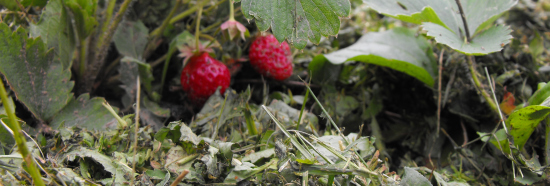
I'm careful not to let them touch any plants, since fresh clippings can
heat up as they decompose. In about a week, they've all turned
brown and are mostly dry, though I noticed a bit of mildew on the
bottom layer (presumably the reason other gardeners prefer to dry the
clippings before applying them. Some urban flower gardeners have
complained about a bad smell as their glass clippings decompose.)
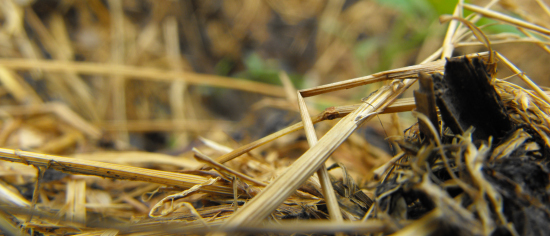
Six weeks later, the grass clippings have nearly disintegrated into the
soil. The quick decomposition of grass clippings is both their
upside --- they quickly feed your vegetable beds --- and their downside
--- they won't provide a long term weed barrier. I use the
clippings around annuals where I don't mind checking back at intervals
to make sure the beds are still weed-free.
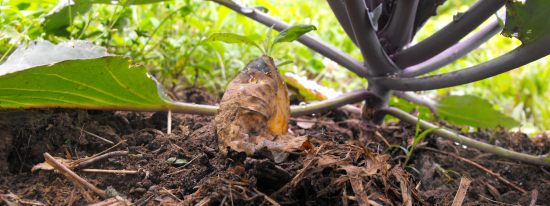
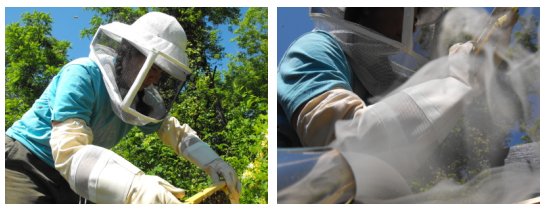
I've heard people say bee keeping is easier than a cat and harder than
a dog. Whoever started that saying probably never had a cat tear a hole
in their kitchen screen.
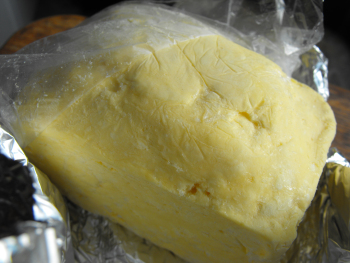 I
adore fresh, raw milk, and once I believed that I'd some day own a milk
goat. But the infrastructure demands are just too high ---
pasture, high security fences, neighbors willing to milk morning and
evening when we're away. I'm not ruling out dairy animals
forever, just for the foreseeable future.
I
adore fresh, raw milk, and once I believed that I'd some day own a milk
goat. But the infrastructure demands are just too high ---
pasture, high security fences, neighbors willing to milk morning and
evening when we're away. I'm not ruling out dairy animals
forever, just for the foreseeable future.
But, as Mark likes to say, "Anna gets what she wants." He's been
networking, trying to hunt down someone who'd sell us raw milk.
Given the legal
situation, I understand it's a lot like trying to find a drug
dealer.
Last week, we got a little nibble --- someone willing to sell us fresh,
homemade butter. I hope the butter will be like a foot in the
door toward milk.
Meanwhile, I just read in Mother Earth News that butter
from pastured cows is highest in vitamins at this time of year.
Just like the yolks from pastured poultry eggs, butter from summer
pastured cows is yellower and considered a premium product. So we
plan to stock up and sock summer butter away in the freezer to feed us
through the long, hard winter.
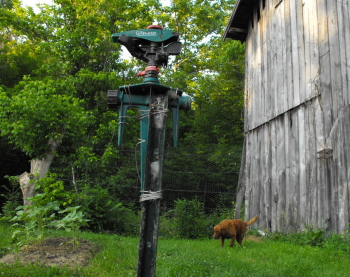 We almost had to bring the sprinklers out this
week, but a few good rounds of natural rain made everybody in the
garden happy.
We almost had to bring the sprinklers out this
week, but a few good rounds of natural rain made everybody in the
garden happy.
Hopefully the rain will continue to be reliable.
A couple of sprinklers mounted on metal fence posts worked well for us
last year. The extra height increased the distance a bit and made it
easy to reposition.
The water comes directly from a pump in the creek, so the pressure is
enough to handle three sprinklers, but two seem to work best.
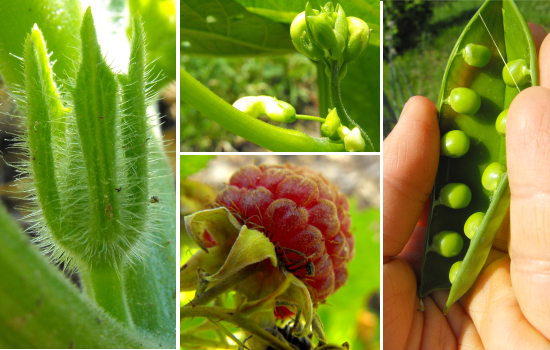
Diversity is starting to
pick up in our fresh garden produce. Sunday, we ate the first
dozen red raspberries along with a bowl of shelling peas. The
strawberries are hitting the end of their season, as is the lettuce and
spinach, but greens and snow peas and shiitakes are still barreling
along. Meanwhile, our squashes and green beans all show signs of
blooms.
Mark and I have an interesting philosophy on freshness of food. I
believe in picking fruits and vegetables moments before we pop them in
our mouths, and we've found that many of them taste just as good or
better raw. There's nothing quite like fresh shelling peas
slipped out of the pod with your teeth.
 I'm
always excited when our readers email me interesting suggestions for
simple living. In fact, I've had three great bits of information
sitting in my inbox for nearly a month, just waiting to be turned into
a lunchtime series. Unfortunately, three never grew to four, so I
kept putting it off.
I'm
always excited when our readers email me interesting suggestions for
simple living. In fact, I've had three great bits of information
sitting in my inbox for nearly a month, just waiting to be turned into
a lunchtime series. Unfortunately, three never grew to four, so I
kept putting it off.
Luckily, another tip came in just this morning. I hope you enjoy
this week's gems of homesteading wisdom!
| This post is part of our Readers' Tips lunchtime series.
Read all of the entries: |
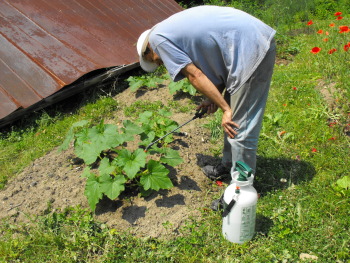 Bt is a natural pesticide we've been using on
our squash and cucumbers for a couple of years now. It was discovered
in 1901 in Japan by Ishiwata, but didn't make it to the commercial
market till the 1950's.
Bt is a natural pesticide we've been using on
our squash and cucumbers for a couple of years now. It was discovered
in 1901 in Japan by Ishiwata, but didn't make it to the commercial
market till the 1950's.
The strain we use only targets moth larvae, certain leaf eating worms
and Gypsy moths, and is safe for animals, humans, and other insects.
We use the liquid type that you mix with water. The shelf life is only
a few years in the bottle if you keep it out of the sun, but I've read
the powder version will last longer.
Bt is a living organism and must be mixed with water that is not too
hard (alkaline). If your water is hard you'll need to add some lemon
juice or other citric acid to bring the pH where you want it.
It takes a couple of days for the bug to die once it's ingested, but
this isn't a problem because they stop eating right away due to the
damage done to their stomach lining.
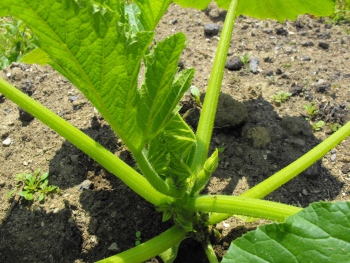 Every garden has an archnemesis, and the squash vine
borer is ours. Unless you've experienced it, it's hard to
imagine the sinking feeling in the pit of your stomach when you go out
and your three foot tall squash plant --- complete with young fruits
--- keels over in an afternoon.
Every garden has an archnemesis, and the squash vine
borer is ours. Unless you've experienced it, it's hard to
imagine the sinking feeling in the pit of your stomach when you go out
and your three foot tall squash plant --- complete with young fruits
--- keels over in an afternoon.
Our first vine borer year, I caught the infestation too late, and had
to try the poke-the-caterpillars-with-a-pin method. I'm here to
tell you that doesn't work.
So now we spray Bt once a week. I'm not entirely comfortable with
it, even though Bt is a bacterium, not a chemical. If anyone has
had good luck killing off their squash vine borers another way, I'd be
curious to hear it.
Want
some honeybees but don't have $200 to start a hive? Everett wrote
in a few weeks ago to give us some pointers on catching swarms.
Every spring, crowded bee colonies decide to split up. The old
queen
makes a new queen to take over her old hive, then she and a bunch of
workers fly the coop. The mass of bees --- a swarm --- heads off
in search of a new hive. If you play your cards right, that new
hive can end up in your backyard, a source of honey for years to
come.
Smart beekeepers put up fliers and contact the local police and fire
departments, alerting them that they're ready to capture swarms.
Everett wrote about his
experience catching swarms on his blog.
If we hadn't gotten in on the extension service grant, we'd definitely
give swarm hunting a shot!
| This post is part of our Readers' Tips lunchtime series.
Read all of the entries: |
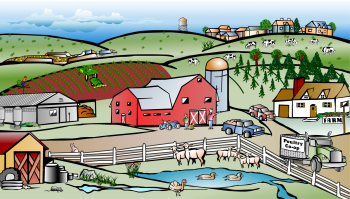 I was looking for some farm trivia
recently and found a very interesting
website by a guy named A.O. Kime.
I was looking for some farm trivia
recently and found a very interesting
website by a guy named A.O. Kime.
Looks like 1954 was the first year more tractors were used on farms than
horses or mules. I'm not sure if this was a good direction in light of
how out of touch the big factory farms have got from the natural cycle
of things.
He's got a real head scratcher of an article on speaking to a
transcendental cantaloupe that still has me thinking. It's listed in
his Bio-oddities section, which speaks volumes about his out of the box
way of looking at farming and gardening.
There's an article by Patrick Malcolm that's worth checking out on the history of fruit
in America and several more directions to go on his well put
together site.
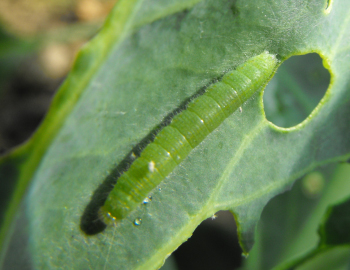 I picked off our first cabbage worms
yesterday. Cabbage worms (which are actually caterpillars, not
worms) are the larvae of cabbage moths (which are actually butterflies,
not moths.)
I picked off our first cabbage worms
yesterday. Cabbage worms (which are actually caterpillars, not
worms) are the larvae of cabbage moths (which are actually butterflies,
not moths.)
With such messed up entomological etymology, it's no wonder I call
cabbage worms "bad bugs." They can be pretty devastating to
cabbage and broccoli leaves, too.
Some organic farmers spray Bt to deal with cabbage worms, just like we
do for squash vine borers. Unless you have a huge garden, though,
that seems like overkill to me. The caterpillars are big and easy
to pick off, so I just handpick them and give them to the chickens,
where they are very well received.
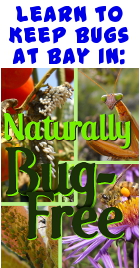 Read other posts about Organic Insect Control: Read other posts about Organic Insect Control: |
Shannon wrote in last month
with some excellent suggestions about bamboo:
 I
am already thinking about how I can put together a chicken tractor or
rabbit hutch with the excess I have this year. It is
rot resistant, strong, etc.
I
am already thinking about how I can put together a chicken tractor or
rabbit hutch with the excess I have this year. It is
rot resistant, strong, etc. I am going to take a trip to a local grower one day. They have varieties that are everything from 1/4" diameter and 8 feet long, to 12" diameter and 80-120' long. I want to plant some of the bigger variety soon.
Another great use for the bamboo once harvested is the dropped leaves make a pretty good natural mulch. I cut down the bamboo, drag them where I want them and then strip off all the branches in a pile. The leaves drop off the branches in about two weeks, then I get a rake and rake up all the leaves and put them in the garden.
Bamboo is a wonder plant as far as I am concerned.
I'd add to Shannon's
advice that it's worth checking out the native North American bamboo,
River Cane, first. Be careful, because some non-native species
can turn invasive. We're looking into planting some River Cane
and some non-invasive timber bamboo.
| This post is part of our Readers' Tips lunchtime series.
Read all of the entries: |
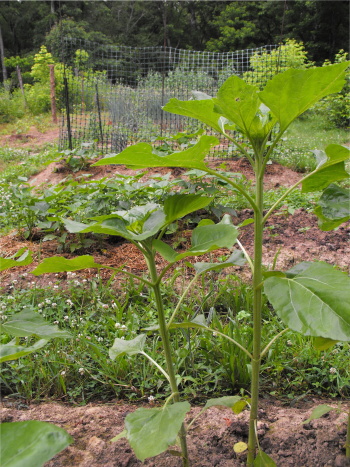 One of our future goals is to grow enough
sunflower plants to turn the seeds into cooking oil.
One of our future goals is to grow enough
sunflower plants to turn the seeds into cooking oil.
I'm not sure if the effort is worth the reward, but thats what
experiments are for. Once you harvest the seeds they need to be
dehulled.
It takes about a pound of hulled seeds to produce 3 ounces of oil. I've
read an area of 2500 square feet can provide a family of four with
enough cooking oil for the year.
There's even talk of it being used as a bio-fuel.
I noticed the feed store had some 40 pound bags of the oil variety for
12 bucks so folks can keep their backyard bird population fed. I might
end up experimenting with one of those bags once we figure out the best
way to build an oil press.
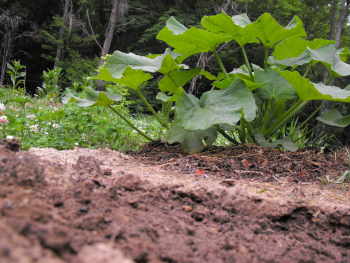 'Tis the season to fill in holes.
Inevitably, my garden ends up with gaps where old seeds didn't
germinate or where my earliest planted peas only came up thinly.
Not only are gaps a waste of space, they're also a weed magnet.
So on Wednesday, I set out to fill the gaps with sweet potato slips and
with broccoli and swiss chard seeds.
'Tis the season to fill in holes.
Inevitably, my garden ends up with gaps where old seeds didn't
germinate or where my earliest planted peas only came up thinly.
Not only are gaps a waste of space, they're also a weed magnet.
So on Wednesday, I set out to fill the gaps with sweet potato slips and
with broccoli and swiss chard seeds.
The hardest part of gap-filling is yet to come, though --- remembering
to keep the seeds watered until they germinate. Last year, I
planted several beds of fall broccoli but didn't get a single plant in
our drought. I hope to do better this year. The
weather is currently cooperating, dropping three tenths of an inch of
rain immediately after I planted.
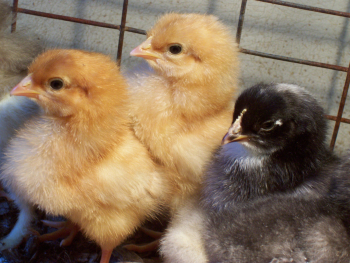 Dennis wrote to give us a
rundown on his most recent broiler chicken operation. I'm
reproducing his entire email below because I think it's worth reading,
but I've inserted a cut for those with limited patience.
Dennis wrote to give us a
rundown on his most recent broiler chicken operation. I'm
reproducing his entire email below because I think it's worth reading,
but I've inserted a cut for those with limited patience.
Raising
chickens for meat is emotionally different from raising them for
egg production. The chicks are just as cute when delivered but,
at
least in my case, I don't identify the birds individually or make any
attempt to observe their habits or individual characteristics.
Chicken
TV is great to watch with your layers and breeding stock but the birds
that we raise for meat are kept in a chicken tractor with little
opportunity to get out and perform. It is just as well, though,
because they are short lived with our normal processing day following
about 8 weeks after delivery. Read more....
| This post is part of our Readers' Tips lunchtime series.
Read all of the entries: |
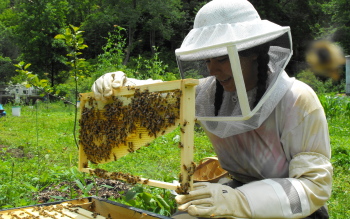 Our bee colonies continue to thrive and grow.
Today was the day to install additional supers for the 3 new hives.
Our bee colonies continue to thrive and grow.
Today was the day to install additional supers for the 3 new hives.
We decided to put the new containers on the bottom in an effort to
encourage upward building.
If honey bees feel like they're running out of space they might be
tempted to swarm, which would be a bad thing at this stage in their
development. We need the hive to stay whole and grow even stronger so
they can make it through the upcoming winter.
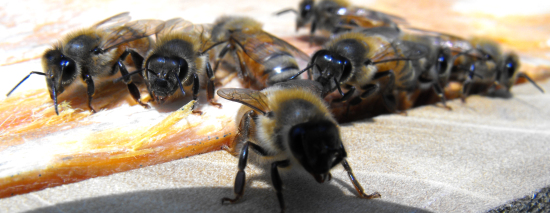
My first and worst mistake was to open the hive on a cloudy day.
It had rained all morning, but by lunchtime the sun was peeking
out. The bees were just beginning to head out to forage, though,
and the hive was extremely crowded. No wonder one wandered up my
sleeve (which should have been tucked in) and stung my arm. I'm
just glad the bee didn't sting while wandering over more sensitive
areas looking for a way out. Luckily, Mark didn't get a shot of
me ripping off my shirt and running half naked toward the trailer. 
I found a very
useful pdf with two pages of pointers on how to act while
inspecting a hive. I'll be more careful next time.
Our last bit of
homesteading wisdom is perhaps the best of the lot. Jeremy from Adirondack Stone Works kept
it short and sweet:
 I would say that the most important tip I have
for home business and
homesteading is this: the joy and love I bring to a project sets the
tone of the project. The feeling I get from a project is the fuel
I use to
move forward.
I would say that the most important tip I have
for home business and
homesteading is this: the joy and love I bring to a project sets the
tone of the project. The feeling I get from a project is the fuel
I use to
move forward. This is why I think it is important to find the positive story about a project. It's unreasonable to expect ourselves to move though all of the obstacles that a homestead or small business will bring without a sustaining, positive story.
I've often found myself dealing with a myriad of stressful thoughts about all of the things I have to do. This stress is poor fuel for getting things done. If I think of a project like "the garden" and stressful thoughts come up, I have less energy for the garden just when I likely need more energy. I really do believe that a positive or negative story is a self-fulfilling prophecy.
Jeremy's advice is
something I've been working hard to incorporate into my own life in the
last six months. Perfect timing to hear it voiced so
succinctly and well. Thanks, Jeremy!
| This post is part of our Readers' Tips lunchtime series.
Read all of the entries: |
 Our micro business is off to a good start
thanks to Anna's experiments with internet marketing.
Our micro business is off to a good start
thanks to Anna's experiments with internet marketing.
If you're looking for some good free advice in this department I
recommend checking out the
micro-niche maverick website.
It just got started in March of this year, but what's there is some
valuable and up to date gems on this ever changing field.
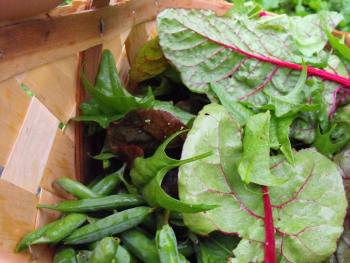 Half
a basket of swiss chard, spinach, and shelling peas swung into the
kitchen. A pint of blanched greens and a cup of blanched peas
trotted out of the kitchen.
Half
a basket of swiss chard, spinach, and shelling peas swung into the
kitchen. A pint of blanched greens and a cup of blanched peas
trotted out of the kitchen.
Like everything in the garden, freezing for the winter begins slowly,
but I expect it to pick up speed soon. Time to get those last few
gallons of 2008 produce out of the freezer to make space for 2009.
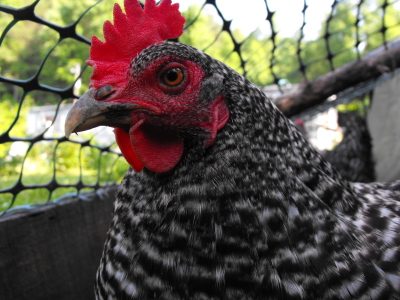 If I had to choose a favorite breed from our
flock of hens I would have to go with this group of Plymouth Rocks.
If I had to choose a favorite breed from our
flock of hens I would have to go with this group of Plymouth Rocks.
Why you ask?
Maybe because they strut around with this look and attitude like they
own the place?
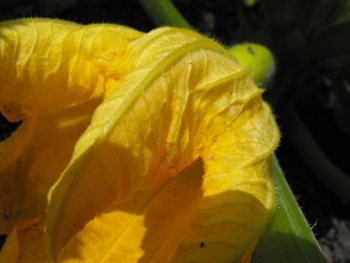 I could see the first squash blossom from the
window when I woke up --- a blaze of yellow-orange on the far side of
the garden. And back behind the bloom...could that be a
developing ovary?
I could see the first squash blossom from the
window when I woke up --- a blaze of yellow-orange on the far side of
the garden. And back behind the bloom...could that be a
developing ovary?
Despite my tendency toward heirlooms, we go the complete opposite
direction with summer squash. We plant a hybrid --- Gold Rush ---
which is as prolific as a zucchini but has a taste we keep coming back
to.
And, while most squashes spend a while making male flowers when they're
young, Gold Rush seems to start out with all female flowers.
Which means we could be eating squash as early as next week! I
wish I could find an heirloom with this kind of track record, but for
now we'll stick with the hybrid.
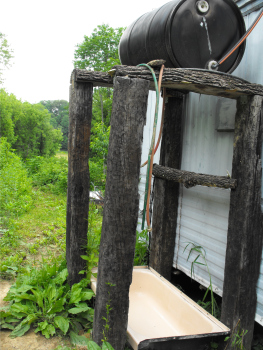 I finally got around to ripping the bathtub
out of our miniscule bathroom this weekend and lugged it outside under
the sun. By winter, I hope to have constructed a simple bathing
chamber out there with glass walls, a passive solar water heater, and a
simple graywater system. For now, I'm just thrilled to be able to
soak in a bathtub rather than in the washtub. (Yes, I used to
wash up outdoors in the washtub rather than indoors in the bathtub ---
I just don't like bathing indoors if there's another choice.)
I finally got around to ripping the bathtub
out of our miniscule bathroom this weekend and lugged it outside under
the sun. By winter, I hope to have constructed a simple bathing
chamber out there with glass walls, a passive solar water heater, and a
simple graywater system. For now, I'm just thrilled to be able to
soak in a bathtub rather than in the washtub. (Yes, I used to
wash up outdoors in the washtub rather than indoors in the bathtub ---
I just don't like bathing indoors if there's another choice.)
Sunday in a
nutshell ---
a plethora of library books to choose between, a purring cat to pet,
double chocolate chip cookies, and a bathtub in the great
outdoors. Is
there really anything better in this world?
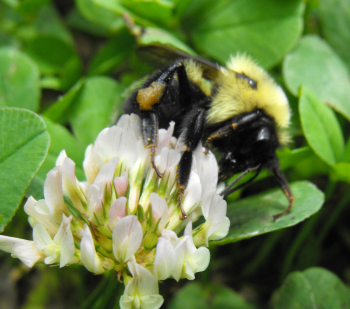 I
like honeybees as much as the next farmer, but I have to admit that I
roll my eyes a bit when the media reports that the decline of the
honeybee could cause us all to starve to death. How do those
reporters think that American plants got pollinated before we
introduced the honeybee from Europe?
I
like honeybees as much as the next farmer, but I have to admit that I
roll my eyes a bit when the media reports that the decline of the
honeybee could cause us all to starve to death. How do those
reporters think that American plants got pollinated before we
introduced the honeybee from Europe?
We've got scads of wild pollinators, but the one I see most often in my
garden is the bumblebee. In fact, despite having four hives of
honeybees, I tend to see more bumblebees than honeybees. I
figured this intrepid pollinator deserves a lunchtime series all her
own!
| This post is part of our Bumblebee lunchtime series.
Read all of the entries: |

I've washed a lot of dishes in my time...and read each and every
soapy adventure in the compelling story of Dishwasher
Pete's
cross country journey.
I'm sure he would back me up here when I say the Lok-Spin
sink strainer is the ultimate in water trapping sink technology.
I just installed two in our sink last week and couldn't be happier with
the look and functionality of this practical and affordable kitchen
innovation.
The strainer has a small dial that threads to the bottom section
creating an unstoppable barrier. No matter how rough you are with the
suds this stopper will never be accidentally dislodged.
 With
all of this rain (another inch and a half yesterday), I have to keep an
eye on the potatoes. Dirt tends to wash away from the highest
tubers, leaving bare tops which turn green in the sun. So I've
changed my mulch priorities from tomatoes to potatoes and am slowly
covering up the rows of tubers with grass clippings.
With
all of this rain (another inch and a half yesterday), I have to keep an
eye on the potatoes. Dirt tends to wash away from the highest
tubers, leaving bare tops which turn green in the sun. So I've
changed my mulch priorities from tomatoes to potatoes and am slowly
covering up the rows of tubers with grass clippings.
I've always been intrigued by the history of our crop plants, and
potatoes have some of the best stories. They've been cultivated
in the Andes in South America for about 7,000 years, but didn't leave
the continent until Spanish explorers brought the plants back to Europe
in the sixteenth century. Even then, the potato had a very
limited appeal --- it was considered fit only for the lower classes and
was mostly used to feed hospital patients.
Two hundred years later, the potato wandered up to Ireland, where it
was welcomed with open arms. The Irish discovered that an acre of
potatoes could feed 10 people, and the population of Irish people and
potatoes quickly exploded...only to crash together sixty years later
when the potato famine proved the dangers of monoculture. If you
haven't heard enough, check out this
page which has even more fun stories about potato history.
Bumblebees
are a lot like big honeybees in terms of behavior. The major
differences
are that bumblebees have smaller colonies which start from scratch each
spring since only the queen overwinters. Bumblebee.org has a nice
rundown on their life
cycle and foraging
behavior, for those who are
interested.
Like honeybees, bumblebees are generalists which pollinate a long list
of plant species.
But bumblebees are especially important for a few species of plants ---
notably tomatoes and blueberries --- which require buzz
pollination. These plants have pollen
which doesn't
easily brush off the anthers of the flowers. Instead, bumblebees
have to land on the flowers and vibrate their flight muscles, causing a
buzz which knocks the pollen loose.
Honeybees don't buzz, so buzz pollinated plants pretty much depend on
bumblebees. Greenhouse tomato growers
have experimented with using vibrators to pollinate their tomatoes, but
finally settled on bumblebees as the easier and cheaper solution.
| This post is part of our Bumblebee lunchtime series.
Read all of the entries: |
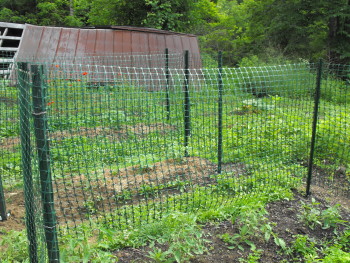 I'm trying a new method of support for the
tomatos this year that involves the 4 foot high green plastic
fence material that comes in 50 foot rolls for 27 bucks at Lowes.
I'm trying a new method of support for the
tomatos this year that involves the 4 foot high green plastic
fence material that comes in 50 foot rolls for 27 bucks at Lowes.
It's a 3 sided enclosure that provides easy access for weeding and
pruning.
We invested in the next size up fence post, which cost nearly 5 dollars
each. It really seems like the best option if you expect to repeat this
procedure year after year in a different spot.
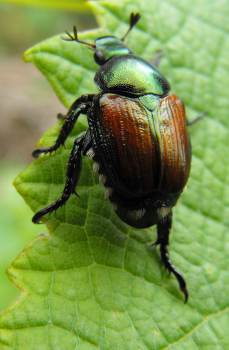 I
noticed the first Japanese Beetles in our garden yesterday --- three
shiny, metallic insects sitting on the top of our dwarf lemon
tree. I've actually been looking forward to their arrival this
year since I want to try out a new control technique I recently heard
about.
I
noticed the first Japanese Beetles in our garden yesterday --- three
shiny, metallic insects sitting on the top of our dwarf lemon
tree. I've actually been looking forward to their arrival this
year since I want to try out a new control technique I recently heard
about.
When the first Japanese
Beetles emerge
from their underground
grub stage,
they find a plant they like to eat
and then emit congregation pheremones. As other beetles emerge,
they follow the scent to have a Japanese Beetle party. According
to a few sources, all you have to do to protect your plants is be
extremely vigilant at this time of year and handpick the first few
beetles off the plants you like. The beetles you leave on nearby
weeds will attract all of the newly emerging beetles to harmless beetle
parties.
Japanese Beetles are
exremely easy to handpick in the morning when
they're sluggish from the cold. Fill a cup partway up with water,
hold it under the beetle, then tap the leaf slightly. Scared
Japanese Beetles naturally let go of their perch and fall down, right
into your cup. Once I've done my rounds, I toss water and beetles
into the chicken tractors where the beetles are quickly consumed.
 Read other posts about Organic Insect Control: Read other posts about Organic Insect Control: |
| Read other posts about alternative chicken feed: |
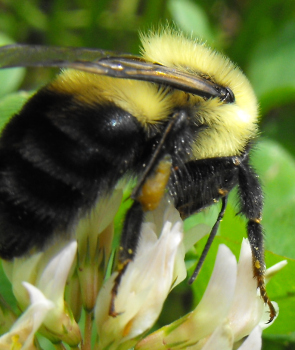 Once
I learned that there are about 24 species of bumblebees in eastern
North America, I wanted to know exactly which kind I had in my
garden. Identification seems like it should be pretty simple --- keys like
this one
break it down to a matter of color pattern. Unfortunately,
once I plugged in all of my choices, the key still said it didn't have
enough data to decide between nine species.
Once
I learned that there are about 24 species of bumblebees in eastern
North America, I wanted to know exactly which kind I had in my
garden. Identification seems like it should be pretty simple --- keys like
this one
break it down to a matter of color pattern. Unfortunately,
once I plugged in all of my choices, the key still said it didn't have
enough data to decide between nine species.
A little more browsing narrowed down the choices. Chances are my
bees are the Common
Eastern Bumblebee. The species is pretty well named since
it's the most common eastern bumblebee. 
| This post is part of our Bumblebee lunchtime series.
Read all of the entries: |
What happens when you combine a small motor with some scrap tin and a
power source? Hopefully a new type of contraption that will make the
deer think twice before they enter our perimeter.
| We finally solved the deer in
the garden problem, and the solution was so elegant we gave it a new
website. Check out our deer
deterrent website for free plans! |
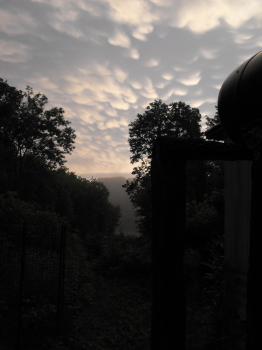 Remember that book I was typing away at six months ago?
Well, I started it in the rain and I finished it in the rain.
Wednesday's stormy weather gave me the incentive to slog through the
second round of editing, which I hope will be the last time I do
anything major with it. Now it's in the hands of my
collaborators, who will work on formatting and a last round of editing.
Remember that book I was typing away at six months ago?
Well, I started it in the rain and I finished it in the rain.
Wednesday's stormy weather gave me the incentive to slog through the
second round of editing, which I hope will be the last time I do
anything major with it. Now it's in the hands of my
collaborators, who will work on formatting and a last round of editing.
I hope to see an actual physical book in my hands by the end of the
summer, early fall at the latest. Even though the book is mostly
local interest (it's a combination trail guide and explanation of
central Appalachian ecology), I'll let you know when copies are out and
looking for a new home.
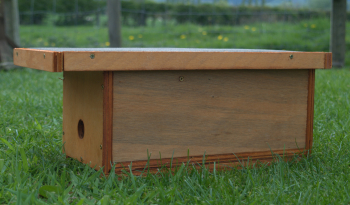 So
what do you do if you want bumblebees in your garden? You need to
provide three types of habitat --- foraging, nesting, and hibernating.
So
what do you do if you want bumblebees in your garden? You need to
provide three types of habitat --- foraging, nesting, and hibernating.
Like honeybees,
bumblebees can be encouraged by having some steady
nectar-producing plants around. Clover is a top choice since it
blooms all summer long, and I can report that our bumblebees
are definitely thrilled by our clover-filled lawn. It helps to
mow the lawn in sections, too, so that there are always bits in bloom.
As for nesting and
hibernating --- some folks buy special bumblebee
boxes like the one shown here, but that seems like a waste of cash to
me. Instead, you can turn a flower pot upside down in an out of
the way spot and cover it with a lid. The bees use the pot as a
protected entrance to the underground burrow where they live. It
goes without saying that you shouldn't rototill near the bumblebee nest
site so that you won't disturb their home. Of course, the easiest
solution is just to leave some areas of your yard completely alone to
grow into native plants and provide a natural nesting and hibernating
ground.
| This post is part of our Bumblebee lunchtime series.
Read all of the entries: |
I shot this 15 second video today of our oldest hen drinking from the
Avian Aqua Miser, an automatic chicken waterer. She and her sisters are still providing a steady
stream of fresh eggs as they turn the corner on their third summer here
on the farm.
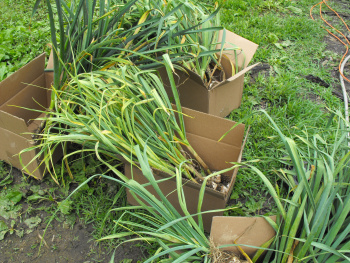 Good
things come to those who wait. And experiment. And research.
Good
things come to those who wait. And experiment. And research.
We planted cloves of
garlic straight from the grocery store in January
2007 and got pretty much no yield. September 2007, we put in some
top bulbs from my Mom, again to no avail. Finally, last October,
we got it right, planting
four varieties of Virginia-grown garlic in carefully built raised beds. And look at the
harvest!
Actually, we probably
should have dug our garlic about a week
ago. As you can see in the photo to the right below, a few of the
heads had lost their outer wrapper layer, meaning that we waited a bit
long to harvest. This
website gives the
best description I've seen of how to plant, harvest, and cure your
garlic.
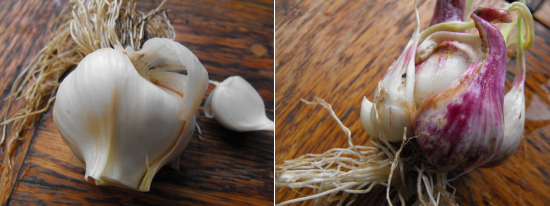
Despite the fact that
we're really supposed to let our garlic cure for
a couple of weeks to get the best garlic flavor, I couldn't resist
harvesting our first basil of the year and doing a pesto
taste-test. We weren't really sure we could tell the difference
between the varieties, so we'll have to test them again once they're
fully cured. All four pestos were delicious, though, especially
after we realized this meant we may never have to buy grocery store
garlic again!
Like honeybees,
bumblebees have been declining in recent years. We messed up
pretty badly when we started raising bumblebees commercially to use in
greenhouses. These imported bees brought along a bunch of
diseases and pests which have spilled out into the wild, harming native
bees.
Pesticides and habitat loss also seem to be part of the problem.
Huge farms don't provide the protected, unplowed areas where bumblebees
can nest, and conventional farmers also tend to spray chemicals which
kill the
bees. Lack of plant diversity is another problem some some
bumblebee species have long tongues and need tube-shaped flowers to
feed on.
The video linked from
the widget to the above gives an excellent rundown on the
issues and the solution. Basically, we're going to have to make
our farms a little wilder if we want bumblebees to keep pollinating our
crops.
| This post is part of our Bumblebee lunchtime series.
Read all of the entries: |
The closer I watch our honey bees the more I'm impressed with their
fancy flying. This video is 15 seconds of heavy return flight traffic
as they time each landing with a certain grace that's a joy to observe.
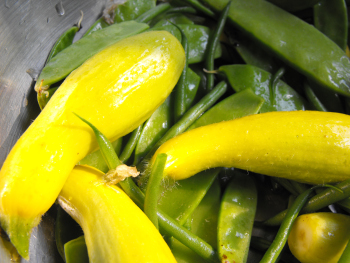 It's been such a bountiful week on the
farm. We're
smack dab in the middle of the spring/summer overlap, when peas are
ending but beans are taking their place. Yesterday alone, we ate
summer squash, green beans, snow peas, carrots, red raspberries,
garlic, basil, and eggs. With vegetables this good, it almost
doesn't matter how I cook them --- they're always delicious.
It's been such a bountiful week on the
farm. We're
smack dab in the middle of the spring/summer overlap, when peas are
ending but beans are taking their place. Yesterday alone, we ate
summer squash, green beans, snow peas, carrots, red raspberries,
garlic, basil, and eggs. With vegetables this good, it almost
doesn't matter how I cook them --- they're always delicious.
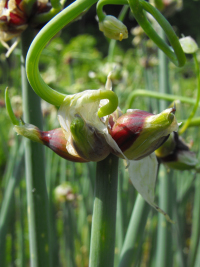 It's
time for a long overdue giveaway! Our Egyptian Onions have
produced top bulbs, far more than we can use ourselves and give away to
our friends. So we've decided to give away twenty top bulbs to
one lucky reader.
It's
time for a long overdue giveaway! Our Egyptian Onions have
produced top bulbs, far more than we can use ourselves and give away to
our friends. So we've decided to give away twenty top bulbs to
one lucky reader.
For those of you
unfamiliar with Egyptian onions, these are some of my
favorite garden plants. The onions are perennials, and while you
can eat the small bulbs most people grow them for the greens --- my CSA
customers unanimously told me that even people who don't like green
onions like these greens.
To enter the
giveaway, just leave a comment on any post by June 30. I'll
throw your name in the hat (multiple times if you make multiple posts)
then will contact the winner through the blog in July. (Be sure
to check back on July 1 to see if you won!) That way you
have an incentive to leave us lots of comments. I look
forward to hearing from you!
Read more about our Egyptian Onions (and how you can get some free by
ordering 3 Avian Aqua Misers) here.
It seems like the noise is doing its job of keeping the deer at a safe
distance from the garden. The pivot points needed some adjusting due to
it getting hung up on the third night of operation. I just increased
the hanging loop size and moved it out a few inches.
You would think a noise like that would be hard to deal with in such an
otherwise tranquil setting, but the opposite is true. When I wake up in
the middle of the night I now listen for the metal scraping on metal,
which gives me an odd sense of comfort knowing that we have an
invisible cloak of noise protecting the garden.
| We finally solved the deer in
the garden problem, and the solution was so elegant we gave it a new
website. Check out our deer
deterrent website for free plans! |
 Nearly a thousand years ago, Native Americans
mounded up rock and earth into a quarter mile long serpent, winding
over the top of an Ohio knoll. Mark grew up nearby and had been
to Serpent Mound
before, but I'd never managed to go. Randomly, I looked it up on
Friday and discovered that the sun sets over the head of the serpent on
the Summer Solstice. With the solstice so near, we figured it was
a sign we should take a road trip!
Nearly a thousand years ago, Native Americans
mounded up rock and earth into a quarter mile long serpent, winding
over the top of an Ohio knoll. Mark grew up nearby and had been
to Serpent Mound
before, but I'd never managed to go. Randomly, I looked it up on
Friday and discovered that the sun sets over the head of the serpent on
the Summer Solstice. With the solstice so near, we figured it was
a sign we should take a road trip!
I'm a very skeptical person when it comes to religion and spirituality,
but I let my normally skeptical mind quiet down for the day and instead
enjoyed the power of an enormous snake winding across the ground.
Like my visit to Stonehenge nine years ago, though, I was disappointed
by the signs which admonished us to stay on the path and away from the
mound. "I wish we could go in there," I said to Mark, pointing
into the hollow center of the head where all of power of the snake must
be concentrated (if you believe that kind of thing, which I
don't.) Read much
more, in which we receive spirit names and go with the flow....
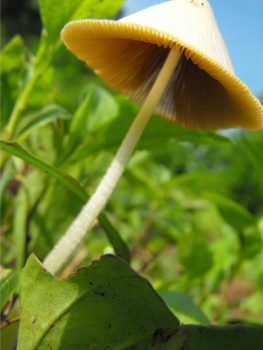 I
get so carried away by our grand vision and the endless nitty gritty it
takes to get there. But isn't the Walden Effect really about the
intangible beauty and serenity of living on the land?
I
get so carried away by our grand vision and the endless nitty gritty it
takes to get there. But isn't the Walden Effect really about the
intangible beauty and serenity of living on the land?
As Guillaume
Apollinaire once said:
happy.
So, this week's lunchtime series is a photo journey toward homestead
happiness. Enjoy!
| This post is part of our Photos of Homestead Happiness lunchtime
series.
Read all of the entries: |
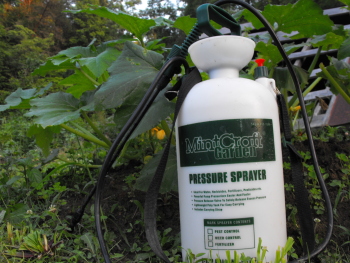 In the early days of spraying Bt I used an old
Windex bottle to apply the fine bacterial mist.
In the early days of spraying Bt I used an old
Windex bottle to apply the fine bacterial mist.
That was a mistake I repeated way too many times before I wised up and
invested in the MintCraft
garden sprayer.
It's a well designed unit that holds a decent amount of pressure.
I give it about 5 or 10 good pumps which will last through a half
gallon of spraying. The extended wand allows you to easily target any
area of the plant while providing a convenient control knob for mist
level adjustments. It gets a bit heavy to carry if you fill it all the
way up, especially if you're using the shoulder strap. You might want
to upgrade the strap with some padding if you do the maximum capacity.
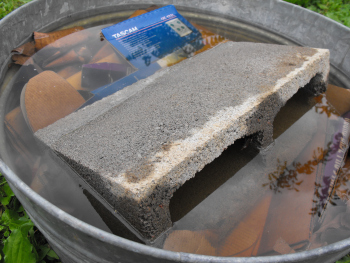 I
have a dirty little secret. I'm an organic gardener, and I
don't compost.
Ssh! Don't tell anyone!
I
have a dirty little secret. I'm an organic gardener, and I
don't compost.
Ssh! Don't tell anyone!
Every organic gardener I
know is obsessed with their compost pile, with
the perfect mix of browns and greens, the perfect temperature, the
perfect moisture content. But I'm lazy, lazy, lazy. I take
my food scraps and I toss them to the chickens, then I let the chicken
manure drop straight into the soil. I only harvest the results
two times removed when I mulch
with grass clippings.
I also truck in horse manure from a neighbor and use pulled weeds to
build new raised beds.
My worm bin does create
compost from the few food scraps chickens won't
eat, but only a gallon or two at a time. Just right for our
potted citrus, but not for much else. Lately, I've been
experimenting with ways to increase our output, and my newest
experiment is to soak cardboard and add it to the bin. I've been
looking for a good use for our junk paper and cardboard --- so hard to
recycle when you live an hour from the nearest recycling center.
It's early days yet, but I have high hopes that the cardboard will add
to our vermicompost.
On the other hand, if you want to go the traditional composting route, you might want to check out this page of composting pointers which Everett put together. It's got short, sweet, and to the point articles about why and how to compost.
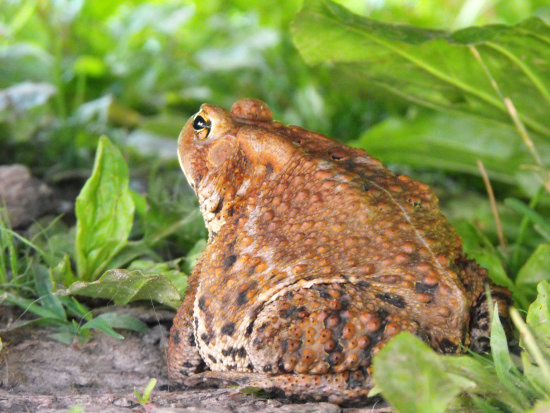
This grand old toad was hiding under the golf cart one day this
month. As I tempted her toward safety, I could nearly hear the
toad admonishing me. "What's the big rush? Slow down!
Smell the flowers!"
| This post is part of our Photos of Homestead Happiness lunchtime
series.
Read all of the entries: |
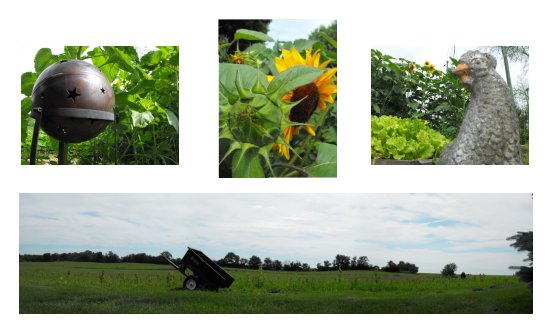
Here are a few pictures from the view up north of my mom's backyard.
We had a smooth trip and a relaxing break that felt like the perfect
way to celebrate the summer solstice.
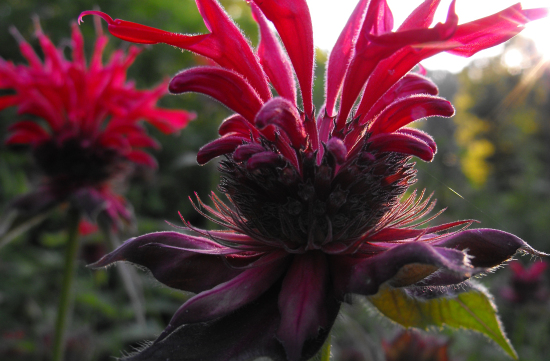
Look who bloomed in our absence! Every gardener has a sentimental
favorite flower, and bee balm is mine. In the past, I've loved
bee balm because it attracts hummingbirds. This year, with our
new bee fetish, I'm curious to see if the plant lives up to its name
when it comes to honeybees.
If you're like me and vastly prefer vegetables to flowers, bee balm is
the perfect flower for you. You can toss this mint-family
perennial in the ground, and once it picks up steam it just keeps
growing and blooming. I tend to weed my bee balm beds every year
or so and spend the rest of my energy just watching the flowers open
all summer long.
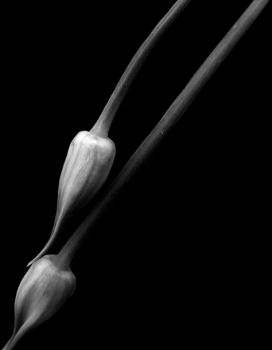 There is
only one success, to be able to spend your life in your own way.
There is
only one success, to be able to spend your life in your own way.
Getting to experience nearly every day with the person I love is what
makes me truly rich.
Two hour lunchbreaks, excitedly brainstorming project ideas. Full
days in the garden working in synchrony. Spur of the moment trips
brimming with fun and laughter.
I watch our strengths
together bypass our individual weaknesses.
rat.
| This post is part of our Photos of Homestead Happiness lunchtime
series.
Read all of the entries: |
 If I was stranded on an island and had to
choose just one power saw, it would have to be one of these
reciprocating
tools.
If I was stranded on an island and had to
choose just one power saw, it would have to be one of these
reciprocating
tools.
They start at just under 50 bucks and can be used in a wide variety of
situations where you need to cut through some wood, metal, plastic or
whatever.
Of course if I was stranded on an isolated island there would most
likely be no electricity...in which case a good hand saw would be the
wiser choice, but if you want a heavy duty cutting tool that can fill
in for almost every saw job imaginable, then one of these should be on
the top of your tool wish list.
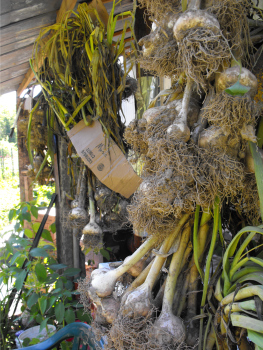 We left rather abruptly on our trip to Ohio
last week, so when I got home I expected to see the farm in
disarray. Honestly, it wasn't so bad --- a few deer nibbles, a
few Japanese beetle clumps, and some weeds were the big problems in the
garden. Our garlic, though, needed help.
We left rather abruptly on our trip to Ohio
last week, so when I got home I expected to see the farm in
disarray. Honestly, it wasn't so bad --- a few deer nibbles, a
few Japanese beetle clumps, and some weeds were the big problems in the
garden. Our garlic, though, needed help.
I had tossed our garlic harvest
into boxes in the bathroom to dry, turning the plants upside down so
that the bulbs popped out the open box tops. Unfortunately, my
box method didn't allow for enough air circulation, so some of the
leaves had started to turn slimy when we got back five days
later. Oops!
Since garlic needs to be out of the sun when it cures, my new method is
to hang the clumps under the porch where they'll get lots of air.
As an added bonus, now we don't have to worry about vampires coming in
our front door!

--- Vicki Robin
The homesteading dream is all
about freedom. The homesteading life
is all about figuring out what to do with that freedom.
Mark is a great one for reminding me to fill my life with what is truly
important --- family, friends, good books, long baths, walking in the
woods, and petting Huckleberry. Your list may vary.
--- Joseph Campbell
| This post is part of our Photos of Homestead Happiness lunchtime
series.
Read all of the entries: |
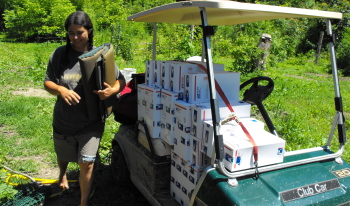 This loaded golf cart picture was taken
yesterday and represents a full day's work of building, packing, and
printing for our automatic chicken waterer microbusiness.
This loaded golf cart picture was taken
yesterday and represents a full day's work of building, packing, and
printing for our automatic chicken waterer microbusiness.
Our local Post Office deserves a big pat on the back for making the
shipping side of our business fun and easy.
 When we got married in
December, I didn't even consider a honeymoon. But Mark is a
serious proponent of treating yourself well, even on a homestead
budget. Wondering how a honeymoon and a budget go together?
Read on.
When we got married in
December, I didn't even consider a honeymoon. But Mark is a
serious proponent of treating yourself well, even on a homestead
budget. Wondering how a honeymoon and a budget go together?
Read on.
Our first thought was to book
passage on a freighter. For about $100 per person per day,
you can live in luxurious accommodations aboard a container ship,
seeing the world in style. Since freighters tend to have only a
handful of passengers and no fancy activities, this is truly the way to
travel for self-sufficient introverts. Someday, we want to hop a
freighter and drift down to Peru to explore Macchu Pichu, but for now
the lengthy duration of freighter trips is out of our price (and time)
range.
Instead, we settled on something I never even considered --- a
Caribbean cruise. Due to the swine flu scare in Mexico and our
current recession, you can book a 5 day cruise for $250 (less if you
don't mind a windowless cabin.) Since that price tag includes
food and accommodations, it's a pretty awesome deal --- it'd be hard to
beat that staying in the motel down the road and eating at
McDonalds. So we bought our tickets for the fall and started to
dream of Mayan ruins!
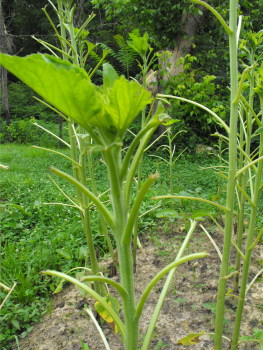 The deer are back in the garden. For
months, I nearly believed that the Predator
Eyes Daddy got me for Christmas worked, but the lack of deer damage
was really just due to plenty of yummy deer fodder in the woods.
The deer are back in the garden. For
months, I nearly believed that the Predator
Eyes Daddy got me for Christmas worked, but the lack of deer damage
was really just due to plenty of yummy deer fodder in the woods.
Three weeks ago, I saw the first strawberry, okra, sweet potato, and
sunflower leaves get nibbled. I quickly threw row covers over the
strawberries and sweet potatoes.
This week, our sunflowers were eaten in stages over four nights until
all that was left was the stalks. Mark's working on deterrents as
fast as he can, but for now I'm hoping that the sunflowers will act as
trap plants --- you know, like some gardeners plant
sacrificial mustard as trap plants to soak up the flea beetles, only
for bigger prey.
Too bad I only planted one bed of sunflowers. I wonder if they'd
protect the garden if I planted a four foot deep row in a circle around
the entire yard?
| We finally solved the deer in
the garden problem, and the solution was so elegant we gave it a new
website. Check out our deer
deterrent website for free plans! |
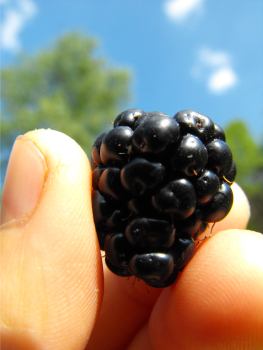 Mark's
been gone for a couple of days at one of his ACF board meetings.
Although I love cooking when he's here, when I'm alone I tend to make
do with bits and pieces of this and that. Saturday, I found
myself
grazing in the garden on fresh carrots, peas, and raspberries.
Then I turned a corner and discovered...the first blackberries!
Delicious!
Mark's
been gone for a couple of days at one of his ACF board meetings.
Although I love cooking when he's here, when I'm alone I tend to make
do with bits and pieces of this and that. Saturday, I found
myself
grazing in the garden on fresh carrots, peas, and raspberries.
Then I turned a corner and discovered...the first blackberries!
Delicious!
Despite planting our
blackberry bushes nearly three years ago, this is our first
fruit. I had to transplant the bushes to a new location after
their first year, which set them back, then a hard freeze wiped out
their fruits in the second year. Finally, in year three, our
patience is rewarded.
(Okay, I lied, this is
the third fruit. Fruits one and two went into my belly before I
went inside for the camera....)
The first contraption I built was not loud enough to be heard in the
garden by the barn and as a result the deer have had their way with our
defenseless sunflowers the past few nights.
This second unit went into testing the night before last and seems to
be
doing just as good of a job as the first one.
| We finally solved the deer in
the garden problem, and the solution was so elegant we gave it a new
website. Check out our deer
deterrent website for free plans! |
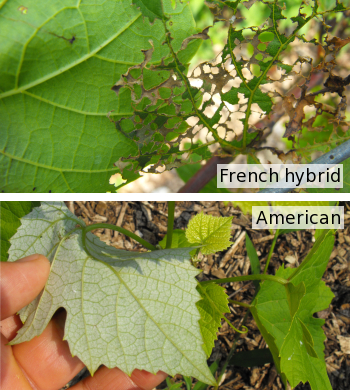 Nearly every other day, I've been picking Japanese
Beetles off our grapes, brambles, and cherry. Sunday morning,
I started to notice that our Japanese Beetles are showing a definite
preference for the thinner, entirely green leaves of our yellow grape
(which I thought was Golden Muscat, but now am not so sure about)
compared to the thicker, white-undersided leaves of Steuben. In
fact, only a few of the Steuben grapes had been touched.
Nearly every other day, I've been picking Japanese
Beetles off our grapes, brambles, and cherry. Sunday morning,
I started to notice that our Japanese Beetles are showing a definite
preference for the thinner, entirely green leaves of our yellow grape
(which I thought was Golden Muscat, but now am not so sure about)
compared to the thicker, white-undersided leaves of Steuben. In
fact, only a few of the Steuben grapes had been touched.
Turns out that the distinction isn't just in my garden. This
Ohio Extension Service factsheet notes that the thin leaves of
French hybrid grapes (bred from a mixture of European and American
ancestors) are far more susceptible to Japanese Beetle damage than are
the thick leaves of American grapes. Steuben is a perfect example
of an American grape while our yellow grape is probably a French
hybrid. This page
gives a longer explanation of the two types of grapes, if you're
interested.
Since I actually prefer the purple fruits of Steuben to the yellow
fruits of the other grape, I'm tempted to pull out the latter in favor
of the former. For now I'll let the yellow grapes grow, but I
think I'll start considering them to be expendable.
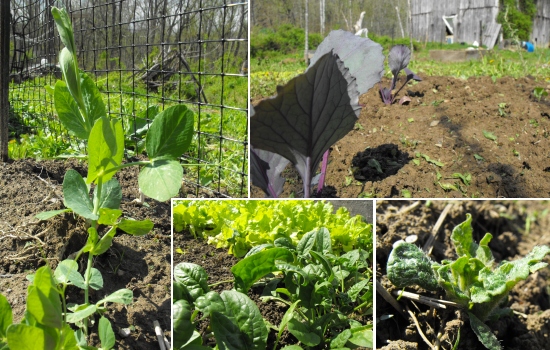
I
tried to start my first fall vegetable garden late one August, when the
heat of summer was still at it's peak. I was shocked to discover
that my crops didn't have time to come to fruition before the cold
weather hit. Yup, that's right, if you want a fall garden, you
need to start right now.
This week's lunchtime
series is a primer on the fall vegetable garden --- what to plant, when
to plant, and how to make your fall garden successful.
| This post is part of our Planning Your Fall Garden lunchtime series.
Read all of the entries: |
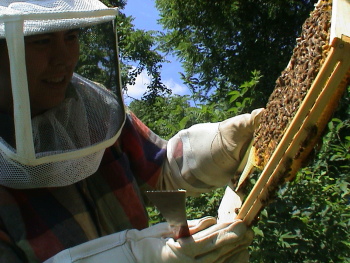 The latest honey bee inspection showed healthy
signs of activity, just not as much building compared to a few weeks
ago.
The latest honey bee inspection showed healthy
signs of activity, just not as much building compared to a few weeks
ago.
We suspect all the rain we've had lately has decreased the pollen and
nectar harvesting.
 Mark and I were both raised on Appalachian
green beans --- pole beans, picked when they're so big they have half
inch seeds inside, then boiled into submission (sometimes for hours)
with bacon. Then we met Masai beans and fell in love.
Mark and I were both raised on Appalachian
green beans --- pole beans, picked when they're so big they have half
inch seeds inside, then boiled into submission (sometimes for hours)
with bacon. Then we met Masai beans and fell in love.
These heirloom, French-style green beans are all we'll eat now, first
and foremost for their exquisite flavor. The tiny beans are sweet
and stringless, so I usually just break them in half and steam them for three minutes,
or toss them in a
skillet with garlic for a few minutes. Either way, they are
phenomenal. Masai beans also freeze extremely well --- we froze
four and a half gallons last year and wished we'd had twice that many.
Of course, Masai beans are also a pleasure to grow. First,
they're heirlooms, so you never have to pay for seeds again.
They're bush beans, too, which means the plants produce big crops all
at once without a trellis. But unlike most bush beans, they just
keep producing big crops all summer, so there's no need to succession
plant. (I do succession plant, but only because I like to have
lots of beds and it's easier to start them scattered throughout the
summer.) The clincher is that they seem to be relatively immune
to bean beetles. Try them out and I suspect you'll write your own
ode to Masai Beans next summer.
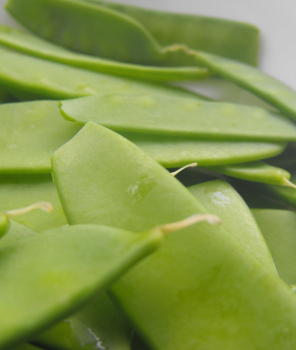 So,
what should you put in your fall garden? It's pretty much like
your early spring garden --- full of crucifers, peas, lettuce, and root
crops.
So,
what should you put in your fall garden? It's pretty much like
your early spring garden --- full of crucifers, peas, lettuce, and root
crops.
I consider our fall
garden to be a catch-up time. If our early peas only
germinate spottily (like this year), fall is a good time to harvest
more to put in the freezer. This is also a good time to plant
root
crops which you'll keep over the winter in a root cellar.
But the fall garden
isn't just an extra spring season. My gardening mentor likes to
tell me that broccoli actually does better as a fall than as a spring
crop around here since the plants don't like extreme heat when they're
heading up. Many cool weather crops are especially tasty in the
fall after the first frost hits --- spring carrots can be a bit strong
tasting in the middle of summer, but fall carrots are sweet and
delicious.
The fall crop, of
course, is also essential to keep you in fresh food as late in the year
as possible. So don't get overwhelmed by the cucumbers and beans
starting to bear fruit right now --- think toward the fall!
| This post is part of our Planning Your Fall Garden lunchtime series.
Read all of the entries: |
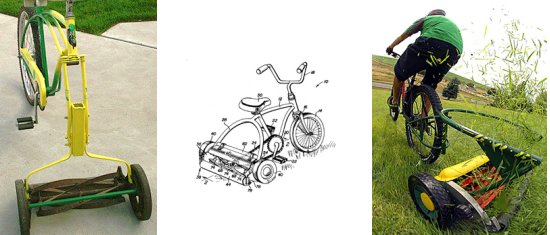
I managed to warp the second mulching mower blade of the summer today
by running over a small stump near the grapes.
On my way to yardpartsexpress.com
(my new home for replacement mower blades) I found an interesting
culture of bike
mowers.
It seems like folks have been merging these two pastimes for several
years now. I'm intrigued by the inventive nature of pedal power being
used to cut grass, but our lawn is so bumpy and rough that it's just
not an option at this time.
Want more in-depth information? Browse through our books.
Or explore more posts by date or by subject.
About us: Anna Hess and Mark Hamilton spent over a decade living self-sufficiently in the mountains of Virginia before moving north to start over from scratch in the foothills of Ohio. They've experimented with permaculture, no-till gardening, trailersteading, home-based microbusinesses and much more, writing about their adventures in both blogs and books.
